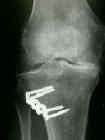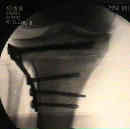- See: TKR following HTO:
- Discussion:
- indications for HTO:
- associated conditions:
- posterolateral corner deficiency
- osteoarthritis of the knee:
- motivation for procedure:
- narrowed medial cartilaginous space may regenerate (and associated degenerative features may reverse) if weight bearing
stresses are partially shifted from the medial to the lateral side of the knee (shifting the mechanical axis from relative
varus to valgus);
- results of osteotomy about the knee are most dependent on the limb alignment and joint line inclination after surgery;
- in a varus knee w/ medial unicompartmental DJD, correction to 8-10 deg of anatomic valgus is associated w/ best prognosis while
knees left w/ residual varus have a less satisfactory result;
- several months need to elapse before the patient is fully mobile, & it is often a year or more before the patient is free of pain;
- by contrast TKR gives almost immediate mobility & relief;
- to the elderly pt the advantage of replacement is obvious;
- biomechanics:
- in the normal knee, loads that are 2-4 times body weight are imposed on tibiofemoral joint, with 60% of the load passing thru
medial compartment;
- w/ unicompartmental DJD, altered limb alignment redistributes more load to affected compartment, which may accelerate
degenerative process and cause pain;
- osteotomy redistributes the loads to the uninvolved compartment.
- success of HTO is related to decreased postop adduction moment at knee;
- Physical Exam:
- when performing either a varus or valgus osteotomy, compensatory arc of motion must be present before surgery;
- for a 20-degree varus osteotomy, 20 deg of abduction is required so pt does not end up with an adduction deformity;
- observe patient ambulate (look for varus thrust)
- note varus / valgus stability;
- patients w/ intrinsic varus deformity can develop attenuation of the lateral collateral ligament from chronic varus thrust;
- patients who develop a varus deformity due to loss of the medial joint space may develop pseudo-valgus laxity of the MCL;
- Q angle of the knee;
- examine the foot and ankle to rule out fixed varus deformities which may worsen medial compartment loading;
- examine for leg length descrepancy:
- if the arthritic side is longer, then a Coventry closing wedge osteotomy might be indicated, where as, if the arthritic side is
shorter (than the other leg), then consider opening wedge osteotomy;
- references:
- Valgus osteotomy with anterior cruciate ligament laxity.
- Gait analysis study on patients with varus osteoarthrosis of the knee.
- Opening wedge high tibial osteotomy for symptomatic hyperextension-varus thrust.
- Alternatives to Valgus Osteotomy:
- remember that it takes 6 months to recover from HTO, and therefore alternatives to HTO are always considered prior to surgery;
- lateral heel wedge to apply valgus moment to the knee;
- valgus loading knee brace (unloads the medial compartment);
- steroid injection;
- role of arthroscopy in HTO
- unicondylar knee replacement
- total knee arthroplasty
- Indications for HTO:
- PreOp Planning:
- radiographs for HTO:
- lateral compartment disease:
- conisder checking a vitamin d level prior to surgery;
- Surgical Options:
- coventry closing wedge HTO:
- opening wedge with plate and graft
- opening wedge external fixator histiogeneis / infra-tubercle osteotomy:
- in the study by Magyar G, et al. (1999), there was no clinical differences between closed and opening wedge osteotomy;
- the authors found the opening wedge technique technically easy, gave precise results, and was well tolerated by patients;
- references: High Tibial Valgus Osteotomy: Closing, Opening or Combined? Patellar Height as a Determining Factor
- dome osteotomy:
- may be concave distal osteotomy (proximal to tibial tubercle) or may be concave proximal (distal to tubercle);
- advantages: adjustability, good bone to bone contact, optimal stability;
- bone ends translate medially at the osteotomy site;
- technical points:
- CORA pin can be placed near proximal medial cortex rather than the center of the bone to create a closing wedge effect;
- ref: Hemicallotasis open-wedge osteotomy for osteoarthritis of the knee. Complications in 308 operations.
- misc:
- role of arthroscopy in HTO
- management of fibula:
- bone grafting:
- ref: Bone Grafts and Bone Substitutes for Opening-Wedge Osteotomies of the Knee: A Systematic Review
- Complications:
- references:
- Late recurrence of varus deformity after proximal tibial osteotomy.
Tibial osteotomy for varus gonarthrosis: indication, planning, and operative technique.
Proximal tibial varus osteotomy for osteoarthritis of the lateral compartment of the knee.
High tibial osteotomy for varus gonarthrosis. A long-term follow-up study.
Proximal tibial osteotomy. Factors that influence the duration of satisfactory function.
Combined Lateral Closing and Medial Opening-Wedge High Tibial Osteotomy.
The Effect of Medial Opening and Lateral Closing High Tibial Osteotomy on Leg Length



